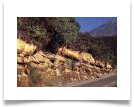Maori and Soils:
Early Maori were aware of the importance of climate and soils, being able to grow the subtropical kumara near the limit of its climatic tolerance. Some eighty varieties of kumara were grown. Today's kumara, hardier and more prolific than the original varieties, was introduced by Europeans.
In the Waikato Basin alone, Maori modified about two thousand hectares of soil for growing crops, of which kumara was the most important.
Kumara gardens were located near rivers and on river terraces. These locations offered protection from wind, and cold air drainage reduced risk of frost damage.
Kumara plantations ranged in size from 0.2 ha to over 20 ha. Plantations were semi-permanent, with the same plots being used for a number of years.
Soil Preparation and Kumera Growing:
Preparation for growing kumara occurred in the autumn. Following burning of existing scrub or tree cover, large stumps were levered out by gangs of men. Lines of workers, each with a digging stick or ko, turned the soil. Roots and other debris were removed for burning.
Kumara planting, an exclusively male activity, had to be completed within a day. Times of planting and harvesting were controlled by the stars and other favourable signs. Planting was done only on a fine day and each tuber was planted with its sprout facing north. Before planting the tohunga or priest invoked blessings of gods such as Rongo - god of peace and gardening, and Pani, the goddess who gave birth to the kumara. Planting was from October to December. From time of planting until harvest in March and April there was a tapu on the plantation. As the welfare of the tribe depended greatly on a successful kumara crop, error or infringement of tapu often resulted in death of the offender.
Using manure was strongly repugnant to Maori, probably stemming from their belief that the Earth Mother, Papa, provided food, and it would be unwise to offend her by using something 'unclean'. Their agriculture was thus probably unique in that manure was never used as fertiliser. Manuka wood ash was used as a fertiliser on soils such as one matua (a firm loam) but not on friable, fertile soils.
The use of gravel to build up a coarser layer on the original soil into which kumara were planted depended on soil type:
click the tabs for content
Soil Preparation and Kumera Growing
Improving the Soils:
Maori were aware that clayey soils needed to be gravelled to improve friability. Why Maori should also gravel gravelly soils is unclear, but there are various suggestions put forward as shown in the diagram to your left.
use mouse over soil horizon: picture or diagram
 |
one matua needed to be gravelled |
 |
one parauma (a dark, friable soil) required gravel only to prevent the kumara leaves getting muddy and wet. |
Tamahere Soils:
Tamahere or Maori soils are sufficiently altered that they show distinct profiles.
To the left is a profile of a soil which has been in rough pasture for about 60 years. The lower part of a ko (digging stick) is shown.
The length of the digging part of the ko corresponds approximately to the depth of the added gravelly topsoil (1), which may explain the irregular lower boundary of the soil horizon. The dark colour of the horizon probably originates from the accumulation of organic matter from (subsequent traditional) European farming practices.
No ash or charcoal is seen in horizon 2, confirming that wood ash was not used as fertiliser.
Horizon 3 represents subsoil that probably originated from a borrow pit.
The charcoal layer (horizon 4) contains wood ash, undoubtedly formed as the original topsoil surface was cleared by burning.
Horizon 5 is mainly made up of original subsoil. The streaks of black are from some buried topsoil.
The original subsoil can be seen in horizon 6.
The gravel bed (7) that underlies the soil would be made of material very similar to the gravel taken from the borrow pit.


